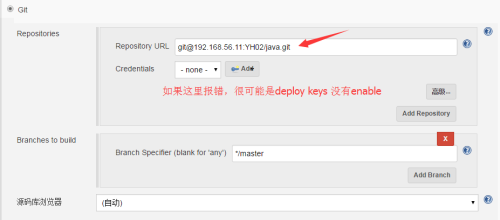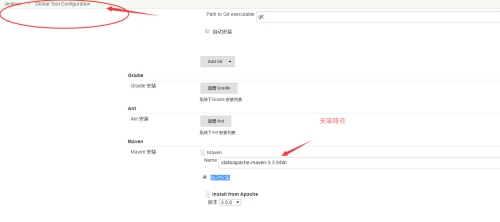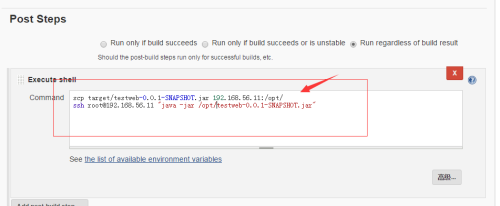一、构建配置搭建
1、创建一个新的项目,选择maven来操作
2、要想构建maven项目,代码库中必须要有一个maven
3、把maven压缩包,解压到一个目录,在当前目录下使用git上传到gitlab项目库
|
1
2
3
4
5
|
git init
git add .
git commit -m
"maven"
git remote add origin git@192.168.56.11:YH02
/java
.git
git push origin master
|
4、在gitlab上面新构建一个项目(例子java)并上传maven项目代码
(1)maven可以在jenkin的系统设置里面的全局工具设置选项里面有manven安装
(2)手动安装maven
|
1
2
3
4
5
6
7
8
9
10
11
12
13
|
apache-maven-3.3.9-bin.
tar
.gz
# 把包上传到jenkins服务器
[root@salt-node2 ~]
# tar xf apache-maven-3.3.9-bin.tar.gz -C /data/
[root@salt-node2 ~]
# ll /data/
total 0
drwxr-xr-x 6 root root 92 May 14 21:40 apache-maven-3.3.9
[root@salt-node2 ~]
# export PATH=$PATH:/data/apache-maven-3.3.9/bin #增加环境变量,可以写到bashrc里面
[root@salt-node2 ~]
# mvn -v
Apache Maven 3.3.9 (bb52d8502b132ec0a5a3f4c09453c07478323dc5; 2015-11-11T00:41:47+08:00)
Maven home:
/data/apache-maven-3
.3.9
Java version: 1.8.0_131, vendor: Oracle Corporation
Java home:
/usr/lib/jvm/java-1
.8.0-openjdk-1.8.0.131-2.b11.el7_3.x86_64
/jre
Default locale: en_US, platform encoding: UTF-8
OS name:
"linux"
, version:
"3.10.0-327.el7.x86_64"
, arch:
"amd64"
, family:
"unix"
|
(3)在jenkins里面填入manve的安装路径
5、SRC是核心文件,pom文件是开发提供
6、保存 开始构建
报错:
maven库不能连接,由于是国外的服务器,这里我们将配置成国内的服务器
编辑maven的配置文件
|
1
2
3
4
5
6
7
8
9
10
11
12
13
14
15
16
17
18
19
20
21
22
23
24
25
26
27
28
29
30
31
32
33
|
[root@salt-node2 ~]
# cd /data/apache-maven-3.3.9/
[root@salt-node2
/data/apache-maven-3
.3.9]
# cd conf/
[root@salt-node2
/data/apache-maven-3
.3.9
/conf
]
# ll
total 16
drwxr-xr-x 2 root root 36 Nov 11 2015 logging
-rw-r--r-- 1 root root 10216 Nov 11 2015 settings.xml
-rw-r--r-- 1 root root 3649 Nov 11 2015 toolchains.xml
[root@salt-node2
/data/apache-maven-3
.3.9
/conf
]
# cp settings.xml settings.xml.bak
[root@salt-node2
/data/apache-maven-3
.3.9
/conf
]
# vim settings.xml
[root@salt-node2
/data/apache-maven-3
.3.9
/conf
]
# vim settings.xml
<?xml version=
"1.0"
encoding=
"UTF-8"
?>
<settings xmlns=
"http://maven.apache.org/SETTINGS/1.0.0"
xmlns:xsi=
"http://www.w3.org/2001/XMLSchema-instance"
xsi:schemaLocation=
"http://maven.apache.org/SETTINGS/1.0.0 http://maven.apache.org/xsd/settings-1.0.0.xsd"
>
<mirrors>
<mirror>
<
id
>yxyc<
/id
>
<mirrorOf>*<
/mirrorOf
>
<url>
#镜像库
<
/mirror
>
<
/mirrors
>
<profiles>
<profile>
<
id
>default<
/id
>
<repositories>
<repository>
<
id
>public<
/id
>
<url>
#本地库
<releases>
<enabled>
true
<
/enabled
>
<
/releases
>
|
查看修改了那些东西
|
1
2
3
4
5
6
7
8
9
10
11
12
13
14
15
16
17
18
19
20
21
22
23
24
25
26
27
28
29
30
31
32
33
34
35
36
37
38
39
40
41
42
43
44
45
46
47
48
49
50
51
52
53
54
55
56
57
58
59
60
61
62
63
64
65
66
67
68
69
70
71
72
73
74
75
76
77
78
79
80
81
82
83
84
85
86
87
88
89
90
91
92
93
94
95
96
97
98
99
100
101
102
103
104
105
106
107
108
109
110
111
112
113
114
115
116
117
118
119
120
121
122
123
124
125
126
127
128
129
130
131
132
133
134
135
136
137
138
139
140
141
142
143
144
145
146
147
148
149
150
151
152
153
154
155
156
157
158
159
160
161
162
163
164
165
166
167
168
169
170
171
172
173
174
175
176
177
178
179
180
181
182
183
184
185
186
187
188
189
190
191
192
193
194
195
196
197
198
199
200
201
202
203
204
205
206
207
208
209
210
211
212
213
214
215
216
217
218
219
220
221
222
223
224
225
226
227
228
229
230
231
232
233
234
235
236
237
238
239
240
241
242
243
244
245
246
247
248
249
250
251
252
253
254
255
256
257
258
259
260
261
262
263
264
265
266
267
268
269
270
271
272
273
274
275
276
277
278
279
280
281
282
283
|
[root@salt-node2
/data/apache-maven-3
.3.9
/conf
]
# diff settings.xml settings.xml.bak
1a2,45
>
> <!--
> Licensed to the Apache Software Foundation (ASF) under one
> or
more
contributor license agreements. See the NOTICE
file
> distributed with this work
for
additional information
> regarding copyright ownership. The ASF licenses this
file
> to you under the Apache License, Version 2.0 (the
>
"License"
); you may not use this
file
except
in
compliance
> with the License. You may obtain a copy of the License at
>
> http:
//www
.apache.org
/licenses/LICENSE-2
.0
>
> Unless required by applicable law or agreed to
in
writing,
> software distributed under the License is distributed on an
>
"AS IS"
BASIS, WITHOUT WARRANTIES OR CONDITIONS OF ANY
> KIND, either express or implied. See the License
for
the
> specific language governing permissions and limitations
> under the License.
> -->
>
> <!--
> | This is the configuration
file
for
Maven. It can be specified at two levels:
> |
> | 1. User Level. This settings.xml
file
provides configuration
for
a single user,
> | and is normally provided
in
${user.home}/.m2
/settings
.xml.
> |
> | NOTE: This location can be overridden with the CLI option:
> |
> | -s
/path/to/user/settings
.xml
> |
> | 2. Global Level. This settings.xml
file
provides configuration
for
all Maven
> |
users
on a machine (assuming they're all using the same Maven
> | installation). It's normally provided
in
> | ${maven.home}
/conf/settings
.xml.
> |
> | NOTE: This location can be overridden with the CLI option:
> |
> | -gs
/path/to/global/settings
.xml
> |
> | The sections
in
this sample
file
are intended to give you a running start at
> | getting the most out of your Maven installation. Where appropriate, the default
> | values (values used when the setting is not specified) are provided.
> |
> |-->
5,31c49,256
< <mirrors>
< <mirror>
< <
id
>baijia<
/id
>
< <mirrorOf>*<
/mirrorOf
>
< <url>http:
//maven
.aliyun.com
/nexus/content/groups/public
<
/url
>
< <
/mirror
>
< <
/mirrors
>
< <profiles>
< <profile>
< <
id
>default<
/id
>
< <repositories>
< <repository>
< <
id
>public<
/id
>
< <url>http:
//maven
.aliyun.com
/nexus/content/groups/public
<
/url
>
< <releases>
< <enabled>
true
<
/enabled
>
< <
/releases
>
< <snapshots>
< <enabled>
true
<
/enabled
>
< <
/snapshots
>
< <
/repository
>
< <
/repositories
>
< <
/profile
>
< <
/profiles
>
< <activeProfiles>
< <activeProfile>default<
/activeProfile
>
< <
/activeProfiles
>
---
> <!-- localRepository
> | The path to the
local
repository maven will use to store artifacts.
> |
> | Default: ${user.home}/.m2
/repository
> <localRepository>
/path/to/local/repo
<
/localRepository
>
> -->
>
> <!-- interactiveMode
> | This will determine whether maven prompts you when it needs input. If
set
to
false
,
> | maven will use a sensible default value, perhaps based on some other setting,
for
> | the parameter
in
question.
> |
> | Default:
true
> <interactiveMode>
true
<
/interactiveMode
>
> -->
>
> <!-- offline
> | Determines whether maven should attempt to connect to the network when executing a build.
> | This will have an effect on artifact downloads, artifact deployment, and others.
> |
> | Default:
false
> <offline>
false
<
/offline
>
> -->
>
> <!-- pluginGroups
> | This is a list of additional group identifiers that will be searched when resolving plugins by their prefix, i.e.
> | when invoking a
command
line like
"mvn prefix:goal"
. Maven will automatically add the group identifiers
> |
"org.apache.maven.plugins"
and
"org.codehaus.mojo"
if
these are not already contained
in
the list.
> |-->
> <pluginGroups>
> <!-- pluginGroup
> | Specifies a further group identifier to use
for
plugin lookup.
> <pluginGroup>com.your.plugins<
/pluginGroup
>
> -->
> <
/pluginGroups
>
>
> <!-- proxies
> | This is a list of proxies
which
can be used on this machine to connect to the network.
> | Unless otherwise specified (by system property or
command
-line switch), the first proxy
> | specification
in
this list marked as active will be used.
> |-->
> <proxies>
> <!-- proxy
> | Specification
for
one proxy, to be used
in
connecting to the network.
> |
> <proxy>
> <
id
>optional<
/id
>
> <active>
true
<
/active
>
> <protocol>http<
/protocol
>
> <username>proxyuser<
/username
>
> <password>proxypass<
/password
>
> <host>proxy.host.net<
/host
>
> <port>80<
/port
>
> <nonProxyHosts>
local
.net|some.host.com<
/nonProxyHosts
>
> <
/proxy
>
> -->
> <
/proxies
>
>
> <!-- servers
> | This is a list of authentication profiles, keyed by the server-
id
used within the system.
> | Authentication profiles can be used whenever maven must
make
a connection to a remote server.
> |-->
> <servers>
> <!-- server
> | Specifies the authentication information to use when connecting to a particular server, identified by
> | a unique name within the system (referred to by the
'id'
attribute below).
> |
> | NOTE: You should either specify username
/password
OR privateKey
/passphrase
, since these pairings are
> | used together.
> |
> <server>
> <
id
>deploymentRepo<
/id
>
> <username>repouser<
/username
>
> <password>repopwd<
/password
>
> <
/server
>
> -->
>
> <!-- Another sample, using keys to authenticate.
> <server>
> <
id
>siteServer<
/id
>
> <privateKey>
/path/to/private/key
<
/privateKey
>
> <passphrase>optional; leave empty
if
not used.<
/passphrase
>
> <
/server
>
> -->
> <
/servers
>
>
> <!-- mirrors
> | This is a list of mirrors to be used
in
downloading artifacts from remote repositories.
> |
> | It works like this: a POM may
declare
a repository to use
in
resolving certain artifacts.
> | However, this repository may have problems with heavy traffic at
times
, so people have mirrored
> | it to several places.
> |
> | That repository definition will have a unique
id
, so we can create a mirror reference
for
that
> | repository, to be used as an alternate download site. The mirror site will be the preferred
> | server
for
that repository.
> |-->
> <mirrors>
> <!-- mirror
> | Specifies a repository mirror site to use instead of a given repository. The repository that
> | this mirror serves has an ID that matches the mirrorOf element of this mirror. IDs are used
> |
for
inheritance and direct lookup purposes, and must be unique across the
set
of mirrors.
> |
> <mirror>
> <
id
>mirrorId<
/id
>
> <mirrorOf>repositoryId<
/mirrorOf
>
> <name>Human Readable Name
for
this Mirror.<
/name
>
> <url>http:
//my
.repository.com
/repo/path
<
/url
>
> <
/mirror
>
> -->
> <
/mirrors
>
>
> <!-- profiles
> | This is a list of profiles
which
can be activated
in
a variety of ways, and
which
can modify
> | the build process. Profiles provided
in
the settings.xml are intended to provide
local
machine-
> | specific paths and repository locations
which
allow the build to work
in
the
local
environment.
> |
> | For example,
if
you have an integration testing plugin - like cactus - that needs to know where
> | your Tomcat instance is installed, you can provide a variable here such that the variable is
> | dereferenced during the build process to configure the cactus plugin.
> |
> | As noted above, profiles can be activated
in
a variety of ways. One way - the activeProfiles
> | section of this document (settings.xml) - will be discussed later. Another way essentially
> | relies on the detection of a system property, either matching a particular value
for
the property,
> | or merely testing its existence. Profiles can also be activated by JDK version prefix, where a
> | value of
'1.4'
might activate a profile when the build is executed on a JDK version of
'1.4.2_07'
.
> | Finally, the list of active profiles can be specified directly from the
command
line.
> |
> | NOTE: For profiles defined
in
the settings.xml, you are restricted to specifying only artifact
> | repositories, plugin repositories, and
free
-form properties to be used as configuration
> | variables
for
plugins
in
the POM.
> |
> |-->
> <profiles>
> <!-- profile
> | Specifies a
set
of introductions to the build process, to be activated using one or
more
of the
> | mechanisms described above. For inheritance purposes, and to activate profiles via <activatedProfiles/>
> | or the
command
line, profiles have to have an ID that is unique.
> |
> | An encouraged best practice
for
profile identification is to use a consistent naming convention
> |
for
profiles, such as
'env-dev'
,
'env-test'
,
'env-production'
,
'user-jdcasey'
,
'user-brett'
, etc.
> | This will
make
it
more
intuitive to understand what the
set
of introduced profiles is attempting
> | to accomplish, particularly when you only have a list of profile
id
's
for
debug.
> |
> | This profile example uses the JDK version to trigger activation, and provides a JDK-specific repo.
> <profile>
> <
id
>jdk-1.4<
/id
>
>
> <activation>
> <jdk>1.4<
/jdk
>
> <
/activation
>
>
> <repositories>
> <repository>
> <
id
>jdk14<
/id
>
> <name>Repository
for
JDK 1.4 builds<
/name
>
> <url>http:
//www
.myhost.com
/maven/jdk14
<
/url
>
> <layout>default<
/layout
>
> <snapshotPolicy>always<
/snapshotPolicy
>
> <
/repository
>
> <
/repositories
>
> <
/profile
>
> -->
>
> <!--
> | Here is another profile, activated by the system property
'target-env'
with a value of
'dev'
,
> |
which
provides a specific path to the Tomcat instance. To use this, your plugin configuration
> | might hypothetically
look
like:
> |
> | ...
> | <plugin>
> | <groupId>org.myco.myplugins<
/groupId
>
> | <artifactId>myplugin<
/artifactId
>
> |
> | <configuration>
> | <tomcatLocation>${tomcatPath}<
/tomcatLocation
>
> | <
/configuration
>
> | <
/plugin
>
> | ...
> |
> | NOTE: If you just wanted to inject this configuration whenever someone
set
'target-env'
to
> | anything, you could just leave off the <value/> inside the activation-property.
> |
> <profile>
> <
id
>
env
-dev<
/id
>
>
> <activation>
> <property>
> <name>target-
env
<
/name
>
> <value>dev<
/value
>
> <
/property
>
> <
/activation
>
>
> <properties>
> <tomcatPath>
/path/to/tomcat/instance
<
/tomcatPath
>
> <
/properties
>
> <
/profile
>
> -->
> <
/profiles
>
>
> <!-- activeProfiles
> | List of profiles that are active
for
all builds.
> |
> <activeProfiles>
> <activeProfile>alwaysActiveProfile<
/activeProfile
>
> <activeProfile>anotherAlwaysActiveProfile<
/activeProfile
>
> <
/activeProfiles
>
> -->
|
二、部署
上面的构建完毕后,接下来是部署了。
我们要在java1上配置里面,写入新的内容,来完成构建完毕后,自动部署的功能!!!
jenkins 打包完毕后,文件会生成到这个目录
|
1
2
3
4
5
6
7
8
9
10
11
12
13
14
15
16
17
18
19
20
21
|
[root@salt-node2 ~]
# cd /var/lib/jenkins/jobs/
java/ java1/ PHP/ php-deploy/
[root@salt-node2 ~]
# cd /var/lib/jenkins/jobs/java1/
builds/ lastStable/ modules/ workspace/
config.xml lastSuccessful/ nextBuildNumber
[root@salt-node2 ~]
# cd /var/lib/jenkins/jobs/java1/workspace/
[root@salt-node2
/var/lib/jenkins/jobs/java1/workspace
]
# ll
total 8
-rw-r--r-- 1 root root 1574 May 14 22:13 pom.xml
drwxr-xr-x 4 root root 28 May 14 22:13 src
drwxr-xr-x 7 root root 4096 May 14 22:25 target
[root@salt-node2
/var/lib/jenkins/jobs/java1/workspace
]
# cd target/
[root@salt-node2
/var/lib/jenkins/jobs/java1/workspace/target
]
# ll
total 8
drwxr-xr-x 3 root root 16 May 14 22:23 classes
drwxr-xr-x 2 root root 27 May 14 22:24 maven-archiver
drwxr-xr-x 3 root root 34 May 14 22:23 maven-status
-rw-r--r-- 1 root root 2435 May 14 22:24 original-testweb-0.0.1-SNAPSHOT.jar
drwxr-xr-x 2 root root 79 May 14 22:23 surefire-reports
drwxr-xr-x 3 root root 16 May 14 22:23
test
-classes
-rw-r--r-- 1 root root 2662 May 14 22:25 testweb-0.0.1-SNAPSHOT.jar
|
三 maven下载的jar包存放在那里了
在家目录下面有一个.m2文件,下载的jar包都会保存在本地这里
|
1
2
3
4
5
6
7
8
9
10
11
12
13
14
15
16
17
18
|
[root@salt-node2 ~]
# cd .m2/
[root@salt-node2 ~/.m2]
# ll
total 4
drwxr-xr-x 13 root root 4096 May 14 22:24 repository
[root@salt-node2 ~/.m2]
# cd repository/
[root@salt-node2 ~/.m2
/repository
]
# ll
total 0
drwxr-xr-x 6 root root 66 May 14 22:24 asm
drwxr-xr-x 3 root root 37 May 14 22:21 backport-util-concurrent
drwxr-xr-x 3 root root 24 May 14 22:19 classworlds
drwxr-xr-x 4 root root 29 May 14 22:25 com
drwxr-xr-x 3 root root 24 May 14 22:19 commons-cli
drwxr-xr-x 3 root root 25 May 14 22:24 commons-lang
drwxr-xr-x 3 root root 32 May 14 22:21 commons-logging
drwxr-xr-x 3 root root 17 May 14 22:24 jdom
drwxr-xr-x 3 root root 18 May 14 22:18 junit
drwxr-xr-x 3 root root 18 May 14 22:21 log4j
drwxr-xr-x 6 root root 61 May 14 22:21 org
|
本文转自 kesungang 51CTO博客,原文链接:http://blog.51cto.com/sgk2011/1926750,如需转载请自行联系原作者







